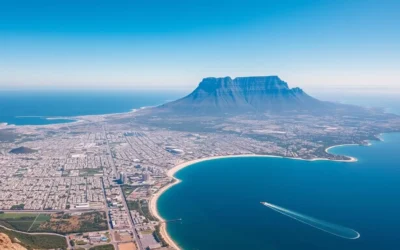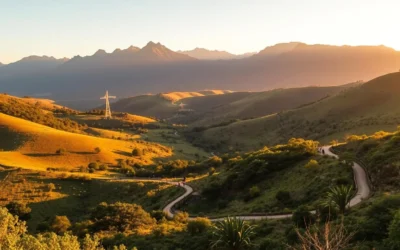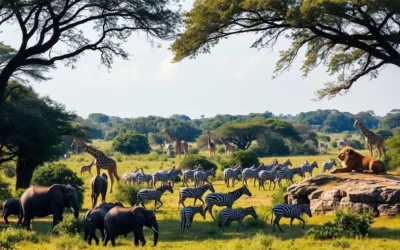✓ Accommodations✓ Flights✓ Rental Cars✓ Tours & Activities
Planning a trip to South Africa can be a thrilling experience, but understanding the country’s diverse climate is crucial for making the most of your journey.
With a vast landscape that encompasses arid deserts, lush tropical coasts, temperate woodlands, and snow-capped mountains, South Africa offers a unique experience regardless of the time of year you visit.
The country’s varied geography creates distinct weather patterns across different regions, making it essential to choose the best time for your trip based on your preferences and the activities you have planned.
Whether you’re looking forward to witnessing the majestic whale migrations, enjoying the blissful sunshine, or experiencing the festive atmosphere, South Africa is a country that has something to offer in every season.
Understanding South Africa’s Diverse Climate
South Africa’s climate is as diverse as its landscapes, ranging from Mediterranean to subtropical and desert conditions. This diversity is influenced by its geography and location in the Southern Hemisphere, where the seasons are reversed compared to the Northern Hemisphere.
Four Seasons in the Southern Hemisphere
You’ll notice that South Africa experiences four distinct seasons, although the temperature variations are not as extreme as in some other parts of the world. Summer highs can reach up to 81 degrees Fahrenheit (28 degrees Celsius), with averages around 77 degrees Fahrenheit (25 degrees Celsius), while mild winters produce average highs of approximately 63 degrees Fahrenheit (17 degrees Celsius). The climate conditions vary significantly across different regions, with temperatures at the coast being more consistent throughout the year.

Regional Climate Variations
As you explore South Africa, you’ll find that regional climate variations are significant. Coastal regions like Cape Town and Durban have different climate patterns compared to inland areas like Johannesburg. The arid and mountainous regions experience the greatest fluctuation in seasonal temperatures. Additionally, rainfall patterns vary across regions, impacting travel planning. Some areas are prone to thunderstorms, particularly in the Highveld region.
South Africa: Best Months for a Weather-Savvy Trip
South Africa’s diverse climate means that the best time to visit varies, but there are certain months that stand out as ideal. Understanding these periods can help you plan a more enjoyable and fulfilling trip.
May to October: The Dry Season Sweet Spot
The dry season, spanning from May to October, is often considered the best time to visit South Africa. During these months, the weather is generally mild and pleasant, making it ideal for outdoor activities and wildlife viewing. The dry conditions also make it easier to spot animals in the national parks and game reserves, as they tend to congregate around water sources.
| Month | Weather Conditions | Ideal Activities |
|---|---|---|
| May | Mild temperatures, dry | Game drives, outdoor adventures |
| June | Cooler mornings and evenings | Whale watching, scenic drives |
| July | Cold in the mornings and evenings | Safari adventures, bird watching |
| August | Comfortable temperatures | Exploring national parks, hiking |
| September | Temperatures rising, dry | Game viewing, photography |
| October | Warm, dry conditions | Outdoor activities, safaris |
November to April: Summer Benefits and Challenges
The summer months, from November to April, bring warmer weather and the rainy season to parts of South Africa. While this period can be challenging due to the heat and occasional showers, it also has its advantages. The landscape becomes lush and green, and it’s an excellent time for birds and other wildlife enthusiasts, as many migratory species are present.

During the summer, certain regions like the Western Cape might be at their best, with pleasant temperatures and fewer crowds in some areas. However, the heat and humidity can be intense in other parts of the country, and summer storms can occur, making it essential to be prepared.
Regional Weather Guide: When to Visit Where
South Africa’s diverse climate means that the best time to visit varies significantly by region. You need to consider the different weather patterns across various regions to plan your trip effectively.
Cape Town and the Western Cape
Cape Town, known for its Mediterranean climate, has warm, dry summers and mild, wet winters. The best time to visit Cape Town is during the spring (September to November) and autumn (March to May), when the weather is pleasant and the crowds are smaller. You can enjoy pleasant temperatures and fewer tourists during these periods.
Johannesburg and the Highveld
Johannesburg experiences a subtropical highland climate, with mild temperatures throughout the year. The summer months (December to February) are ideal for visiting Johannesburg, with warm weather and lush landscapes. However, be prepared for afternoon thunderstorms during this time of year.
Durban and the KwaZulu-Natal Coast
Durban enjoys a tropical climate, with warm temperatures all year round. The summer months can be hot and humid, with short, sharp thunderstorms in the late afternoon. Winters are mild and sunny, making it an ideal destination for those seeking warm winter escapes. You can enjoy the warm water of the Indian Ocean, making it swimmable throughout the year.
- You’ll explore Durban’s subtropical climate that offers warm temperatures year-round with hot, humid summers.
- We’ll explain why May to September provides the most comfortable conditions with mild temperatures and lower humidity.
- You’ll learn about the warm Indian Ocean temperatures that make this coast swimmable throughout the year.
- We’ll highlight the benefits of visiting during the shoulder seasons (April-May and September-October) when weather is pleasant and crowds are thinner.
- You’ll understand how the coastal location moderates temperatures compared to inland areas of KwaZulu-Natal.
Best Months for Safari Adventures
For those eager to experience the best of South Africa’s safari scene, understanding the optimal visiting times is key. The country’s diverse game reserves offer a range of experiences throughout the year, but certain months stand out for their favorable conditions.

Kruger National Park’s Prime Seasons
Kruger National Park, one of Africa’s largest game reserves, is a must-visit destination for any safari enthusiast. The best time to visit Kruger is during the dry season, from May to September, when wildlife is more concentrated around water sources, making game drives particularly rewarding. The dry winter months also offer clearer skies and more comfortable temperatures for visitors.
The dry season is ideal for spotting a variety of game, including the Big Five: lion, leopard, rhinoceros, elephant, and Cape buffalo. With the vegetation being less dense, visibility is improved, enhancing the overall safari experience.
Kgalagadi and Other Game Reserves
Beyond Kruger, other game reserves in South Africa offer unique safari experiences. The Kgalagadi Transfrontier Park, for example, is known for its wildlife adapted to the harsh desert environment, including the majestic black-maned lions. Visiting Kgalagadi during the dry months (May to September) can be particularly rewarding, as the dry conditions concentrate the game around waterholes.
Other notable game reserves include Madikwe and Addo, each offering specialized wildlife viewing opportunities. Madikwe is known for its malaria-free status and diverse game, while Addo is famous for its elephant population. By choosing the right time to visit these reserves, you can maximize your safari experience.
Coastal Experiences: Beaches and Marine Life
The coastal regions of South Africa offer a diverse range of experiences, from relaxing on beautiful beaches to witnessing incredible marine life. Whether you’re looking to soak up the sun or explore the underwater world, understanding the best times to visit is crucial.
Beach Season: When to Soak Up the Sun
South Africa’s beaches are a major draw for tourists, with the summer months (December to February) being the peak season for beachgoers. During this time, the weather is warm, and the conditions are ideal for swimming, surfing, and other water activities. If you prefer milder weather, the shoulder season (November and March to April) can be a good alternative, offering pleasant temperatures without the peak season crowds.
Whale Watching and Marine Activities
South Africa is renowned for its whale watching opportunities, particularly during the winter and spring months. From June to October, humpback and southern right whales can be seen close to shore as they migrate to their breeding grounds off the coast of Mozambique. This period is ideal for witnessing these magnificent creatures. Additionally, the coastal waters offer a range of marine activities, including scuba diving and shark diving. For instance, Aliwal Shoal is a famous spot for shark diving and offers baited shark dives throughout the year.

For those interested in other marine experiences, the Sardine Run, which occurs between June and July, is a spectacular event where millions of sardines migrate along the Eastern Cape and KwaZulu-Natal coasts, attracting a variety of marine predators. This natural phenomenon is a thrilling experience for divers and marine enthusiasts.
| Activity | Best Time | Location |
|---|---|---|
| Whale Watching | June to October | Southern Coast |
| Sardine Run | June to July | Eastern Cape and KwaZulu-Natal |
| Shark Diving | All Year | Aliwal Shoal |
By planning your visit according to the season, you can enjoy a variety of coastal experiences that South Africa has to offer, from relaxing on its beautiful beaches to engaging in exciting marine activities.
Seasonal Natural Phenomena
From wildflower blooms to the Sardine Run, South Africa offers a range of breathtaking natural events throughout the year. These phenomena are not only spectacular but also provide unique opportunities for wildlife viewing and experiencing the country’s diverse natural beauty.
Wildflower Blooms
During August and September, the Western Cape is painted with vibrant colors as the wildflowers bloom. This season is perfect for nature lovers and photographers. The display is a result of the region’s unique climate and soil conditions, creating a breathtaking landscape.
Sardine Run
Between June and July, the Sardine Run takes place along South Africa’s east coast, attracting a variety of marine life. This natural event is characterized by the massive migration of sardines, which in turn attracts predators such as dolphins, sharks, and birds, creating a spectacular feeding frenzy in the water.
| Phenomenon | Time of Year | Location |
|---|---|---|
| Wildflower Blooms | August-September | Western Cape |
| Sardine Run | June-July | Eastern Cape and KwaZulu-Natal coastlines |
These seasonal natural phenomena not only showcase the country’s rich biodiversity but also offer unforgettable experiences for visitors. Whether you’re observing the Sardine Run or marveling at the wildflower blooms, you’re witnessing the incredible wildlife and natural beauty that South Africa has to offer, making your trip a memorable one year after year. The diversity of animals and ecosystems makes South Africa a unique destination for nature enthusiasts.
Month-by-Month Weather and Highlights
As you plan your trip to South Africa, understanding the monthly weather patterns can enhance your experience. The country’s diverse climate means that different regions have distinct weather profiles throughout the year.
Summer (December-February)
Summer in South Africa brings warm to hot temperatures across most regions. It’s an ideal time for beachgoers, with the coastal areas offering pleasant conditions. However, it’s also the wettest season in many parts of the country, including the famous Kruger National Park, where safaris can be more challenging due to the lush vegetation and dispersed wildlife.
Fall (March-May)
Autumn, or Fall, is a transitional season that brings mild temperatures and fewer crowds, making it an excellent time for game viewing. The weather is generally pleasant across the country, with comfortable temperatures ranging from cool mornings to warm afternoons. It’s a great period to visit game reserves and enjoy the dry season, which starts to set in, making wildlife spotting easier.
Winter (June-August)
Winter in South Africa is characterized by cool to cold temperatures, especially in the mornings and nights. However, it’s considered the prime season for safaris due to the clear skies and the concentration of wildlife around water sources. The dry season conditions make it easier to spot animals. It’s also an excellent time for whale watching along the southern coast, as whales migrate to the warmer waters.
| Season | Weather | Activities |
|---|---|---|
| Summer (Dec-Feb) | Hot, wet | Beach activities |
| Fall (Mar-May) | Mild, fewer crowds | Game viewing, safaris |
| Winter (Jun-Aug) | Cool to cold, dry | Safaris, whale watching |
Understanding these seasonal variations can help you plan a more enjoyable and fulfilling trip to South Africa. Whether you’re interested in safaris, beach activities, or exploring the country’s diverse landscapes, there’s a season that’s right for you.
Conclusion: Planning Your Weather-Perfect South African Journey
South Africa is a year-round destination, with each season bringing its own set of exciting experiences. Whether you’re looking for a safari adventure or a relaxing beach vacation, understanding the weather patterns is crucial for making the most of your trip.
The best time to visit South Africa is from May to October, when the dry season offers clear and warm days, ideal for game viewing and game drives. However, every season has its unique charm, from the whale migrations in winter to the blissful sunshine in summer.
By considering your preferred activities and weather preferences, you can plan a trip that suits your needs. With flexibility and preparation, you can enjoy South Africa’s diverse climate zones and make the most of your time in this remarkable country.
The above is subject to change.
Check back often to TRAVEL.COM for the latest travel tips and deals.






